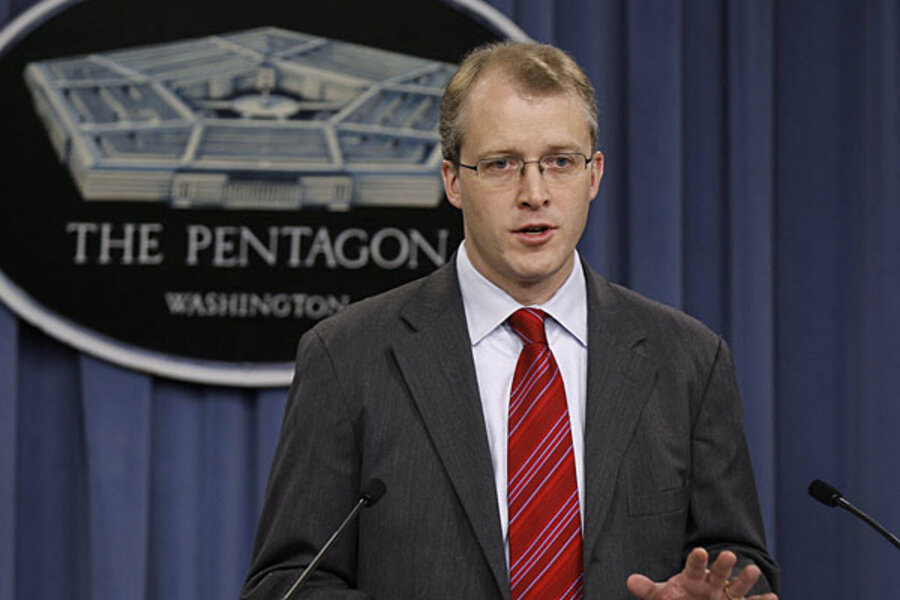Fuller picture emerges of fatal, chaotic US-Pakistan firefight
Loading...
| Washington
As US-Pakistan relations continue to deteriorate after the US military mistakenly killed two dozen Pakistani military troops in late November, a new Pentagon report about the incident paints a picture of chaos on both sides and of US ground forces in Afghanistan pinned down by surprisingly accurate fire from what turned out to be Pakistani forces.
It also points to the emergence of a troubling trend, in which insurgents bent on defeating US and allied forces in Afghanistan disguise themselves as Pakistani military troops to move about more freely near the border – and also perhaps, senior US military officials warn, to bait US forces into behaving in a way that damages US-Pakistan relations.
Brig. Gen. Stephen Clark of the Air Forces Special Operations Command, who led the US military’s investigation of the incident along the Afghanistan-Pakistan border, briefed reporters on the preliminary findings last week, but the full report was not released until Monday.
It provides new eyebrow-raising details of the cross-border “incident,” as the Pentagon report refers to it, which at times is portrayed as a harrowing battle in which US Special Forces were pinned down by Pakistani troops whom they believed to be insurgents.
It was just after 11 p.m. on Nov. 25 that US military ground forces just inside the Afghanistan border in Kunar Province “came under fire from a heavy machine gun” from the Pakistan side, the report states. Within a few more minutes, US forces “came under accurate mortar fire.”
That’s when US troops requested a “show of force” from a fighter jet nearby. An F-15 responded 10 minutes later, “at high speed and at low altitude dispensing flares.”
As the live fire from Pakistani troops continued, US forces apparently considered leaving the area, according to the report. However, the US forces’ team leader “could not extract his troops due to continuing accurate fire.”
The report also noted that “attempts by the GF [ground forces] to move away from their positions at that time would have increased the GF exposure to, and risk from, the fires they were receiving.”
As US forces requested permission to fire back, the team leader “called his superior to verify that the fire was not coming from PAKMIL [Pakistani military] positions.” He was told it was not. US forces than fired a Hellfire missile into a bunker and shot at other “hostile personnel.”
That’s when the Pakistani military reported it was taking fire. US forces fired for a total of 45 minutes during a 90-minute period that left 24 Pakistani troops dead and 13 wounded, according to the report.
In his briefing, Clark cited “overarching lack of trust” as a chief cause of the shooting, with US forces working “under the impression that when they have shared specifics [with their Pakistani counterparts] some of their operations have been compromised.” He added, “It is a perception that is out there, and it is real.”
A problem existed, too, with “incorrect mapping,” according to the report. A “misconfigured” electronic map overlay being used by US forces – and in turn given to a Pakistani liaison officer with whom they were working – incorrectly indicated that the Pakistani military’s location “was 14 kilometers [7-1/2 miles] to the north of the actual engagement area.”
The report, for its part, highlights another possible cause for confusion as well: Insurgents have taken to “wearing PAKMIL [Pakistani military] uniforms in order to move freely across the border.”
That insurgent practice points to a worrisome pattern of “baiting” US forces, military officials fear. “There are certainly incidents where insurgents along the border have instigated a fight [using] direct fires or indirect fire, and they have done so in proximity to [Pakistani] military border locations,” Lt. Gen. Curtis Scaparrotti, deputy commander of US forces in Afghanistan, said last week. “We think it was to draw our attention – or perhaps, in some cases, to draw conflict here between Afghan, coalition, or Pakistan forces.”
In a statement accompanying the release of the report on Monday, Gen. James Mattis, the head of Central Command, which runs the war in Afghanistan, recommended efforts to improve “mutual trust” among US and Pakistani forces, including to “develop and share with Pakistani military if possible the common use of force escalation measures such as show of force and other standard procedures needed to prevent friendly fire incidents.”
“The strongest take-away from this incident is the fundamental fact that we must improve border coordination and this requires a foundational level of trust on both sides of the border,” he added.
Pakistani officials, however, say such trust will be tough to establish without an apology from the United States. In the meantime, US military supply routes through Pakistan to Afghanistan remain closed.
US defense officials have expressed their “deepest regret,” but have issued no apology, stressing in the report that “the catalyst for the engagement was the opening of fire by [Pakistani military] forces,” and that “continued fire from Pakistani forces exacerbated the situation.”





